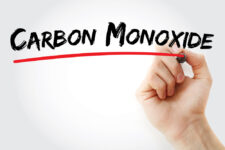Blog
6 Carbon Monoxide Safety Tips
Carbon monoxide is very dangerous and very real. It can also occur in your own home. Consequently, it is important that you understand how to prevent carbon monoxide problems, as well as how to handle them if they occur. Carbon monoxide safety tips are important for every home.
The Dangers of Carbon Monoxide
Carbon monoxide is a gas that forms when other fuels fail to fully combust. It has no smell or color, making it difficult to identify. Unfortunately, this odorless, colorless, flammable gas also happens to be poisonous to your body when inhaled in large amounts. When you inhale, you take in oxygen, carbon monoxide, and carbon dioxide. The carbon dioxide is sent back out when you exhale, but the carbon monoxide takes a little longer (about a day) to leave your body. When the natural balance between oxygen and carbon monoxide is off, your body takes in too much carbon monoxide to safely eliminate. Very quickly, it poisons your body, resulting in health problems at best and death at worst.
If not fatal, carbon monoxide can cause the following health concerns.
- Dizziness
- Nausea
- Headaches
- Brain Damage
- Heart Damage
- Fainting
6 Carbon Monoxide Safety Tips to Apply
Remain proactive against carbon monoxide poisoning by carefully applying these 6 safety tips. Remember, consistency is key!
1. Install carbon monoxide detectors.
Of course, the very first precaution to take against carbon monoxide poisoning is to install carbon monoxide detectors. Just like a smoke alarm, a carbon monoxide detector warns you at the first sign of trouble. Remember, carbon monoxide has no smell or color, so you won’t be aware of its presence without a detector.
2. Test your carbon monoxide detectors regularly.
Likewise, you should test your carbon monoxide detectors monthly to ensure their batteries do not need to be changed. If the batteries are low, change them as soon as possible.
3. Never leave home without checking your gas burners.
If you have a gas stove, always doublecheck to ensure they are completely turned off. Even if you can’t see the flame, a gas burner can still emit carbon monoxide, slowly filling your home with poison.
4. Avoid leaving your car running near your home.
Did you know that your car’s engine produces carbon monoxide? When working on your car, always ventilate by opening the garage door. Never leave your car idling in a tight space, and definitely never sit in it while it is.
5. Remove clutter from heated appliances.
Remember, carbon monoxide is flammable, so make sure to keep heated areas clear. This includes dryers, furnace, stoves, fireplaces, etc.
6. Schedule yearly furnace tune-ups.
Proper HVAC maintenance reduces your chances of experiencing a carbon monoxide leak. Make sure to schedule annual furnace tune-ups by a licensed technician. Preventive maintenance is always better than waiting for a problem to occur, especially if that problem is life-threatening.
What to Do if You Have a Carbon Monoxide Leak
No matter how careful or consistent you may be, there is always the possibility of an uncontrollable gas leak. If a leak does occur, immediately take the following steps.
- Leave your home.
- Call emergency personnel.
- Have your home thoroughly examined for the source of the leak.
Schedule Your Indoor Air Quality Inspection Today
Indoor Air Quality Inc. offers several financing options perfect for homeowners. We want to do what is best for you! If you have any further questions about HVAC financing, service agreements, or warranties, contact Indoor Air Quality today. We serve homeowners in Highlands Ranch and throughout the Denver Metro Area. Our highest priority is the comfort of your home.





